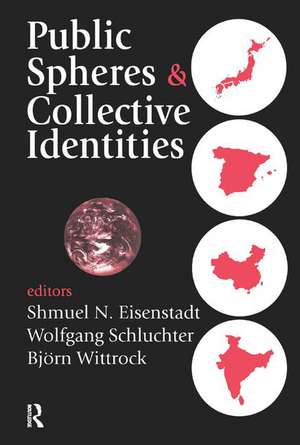Public Spheres and Collective Identities
Autor Walter Lippmann, Wolfgang Schluchteren Limba Engleză Hardback – 28 iun 2018
Following Eisenstadt's and Schluchter's introduction, Bjorn Wittrock explores the varieties and transitions of early modern societies, noting that only by looking at societies' collective identities and their modes of mediating in the public sphere can the distinguishing factors between modernity be appreciated. Sheldon Pollock discusses the use of vernacular language in India through its literary culture and polity, 1000-1500. Sanjay Subrahmanyam, sums up major developments in the recent historiography of South Asia from 1400 to 1750. David L. Howell focuses on the boundaries of the early modern Japanese state, including its political boundaries and the boundaries of collective identity and social status. Mary Elizabeth Berry examines public life in authoritarian Japan. Frederic Wakeman, Jr. probes the boundaries of the political game and how they were affected by the increased political centralization that developed after the disorder of the Ming-Qing transition during the seventeenth century. Alexander Woodside discusses territorial order and collective-identity tensions in Confucian Asia. Bernhard Giesen argues that the French Enlightenment can be described as an extension of absolutist court culture. Finally essay, Victor Perez-Diaz examines the state and public sphere in Spain during the Ancient Regime contrasting two ideal types of states--a "nomocratic" model and a "teleocratic" model.
This volume addresses cultural and political practices not only from outside the European and American spheres but also over long periods of time in which the internal dynamics of other civilizations become visible. Its broad-ranging use of empirical materials enables us to think comparatively and historically about the ways in which different modernities took shape.
| Toate formatele și edițiile | Preț | Express |
|---|---|---|
| Paperback (1) | 436.36 lei 6-8 săpt. | |
| Taylor & Francis – 31 dec 2000 | 436.36 lei 6-8 săpt. | |
| Hardback (1) | 1000.27 lei 6-8 săpt. | |
| Taylor & Francis – 28 iun 2018 | 1000.27 lei 6-8 săpt. |
Preț: 1000.27 lei
Preț vechi: 1219.84 lei
-18% Nou
Puncte Express: 1500
Preț estimativ în valută:
191.41€ • 204.67$ • 159.59£
191.41€ • 204.67$ • 159.59£
Carte tipărită la comandă
Livrare economică 17 aprilie-01 mai
Preluare comenzi: 021 569.72.76
Specificații
ISBN-13: 9781138531260
ISBN-10: 113853126X
Pagini: 291
Dimensiuni: 152 x 229 x 18 mm
Greutate: 0.45 kg
Ediția:1
Editura: Taylor & Francis
Colecția Routledge
Locul publicării:Oxford, United Kingdom
ISBN-10: 113853126X
Pagini: 291
Dimensiuni: 152 x 229 x 18 mm
Greutate: 0.45 kg
Ediția:1
Editura: Taylor & Francis
Colecția Routledge
Locul publicării:Oxford, United Kingdom
Cuprins
Introduction: Paths to Early Modernities—A Comparative View; Early Modernities: Varieties and Transitions; India in the Vernacular Millennium: Literary Culture and Polity, 1000-1500; Hearing Voices: Vignettes of Early Modernity in South Asia, 1400-1750; Territoriality and Collective Identity in Tokugawa Japan; Public Life in Authoritarian Japan; Boundaries of the Public Sphere in Ming and Qing China; Territorial Order and Collective-Identity Tensions in Confucian Asia: China, Vietnam, Korea; Cosmopolitans, Patriots, Jacobins, and Romantics; State and Public Sphere in Spain during the Ancient Regime
Descriere
Today it is assumed that we understand contemporary nationalism and nation-building














